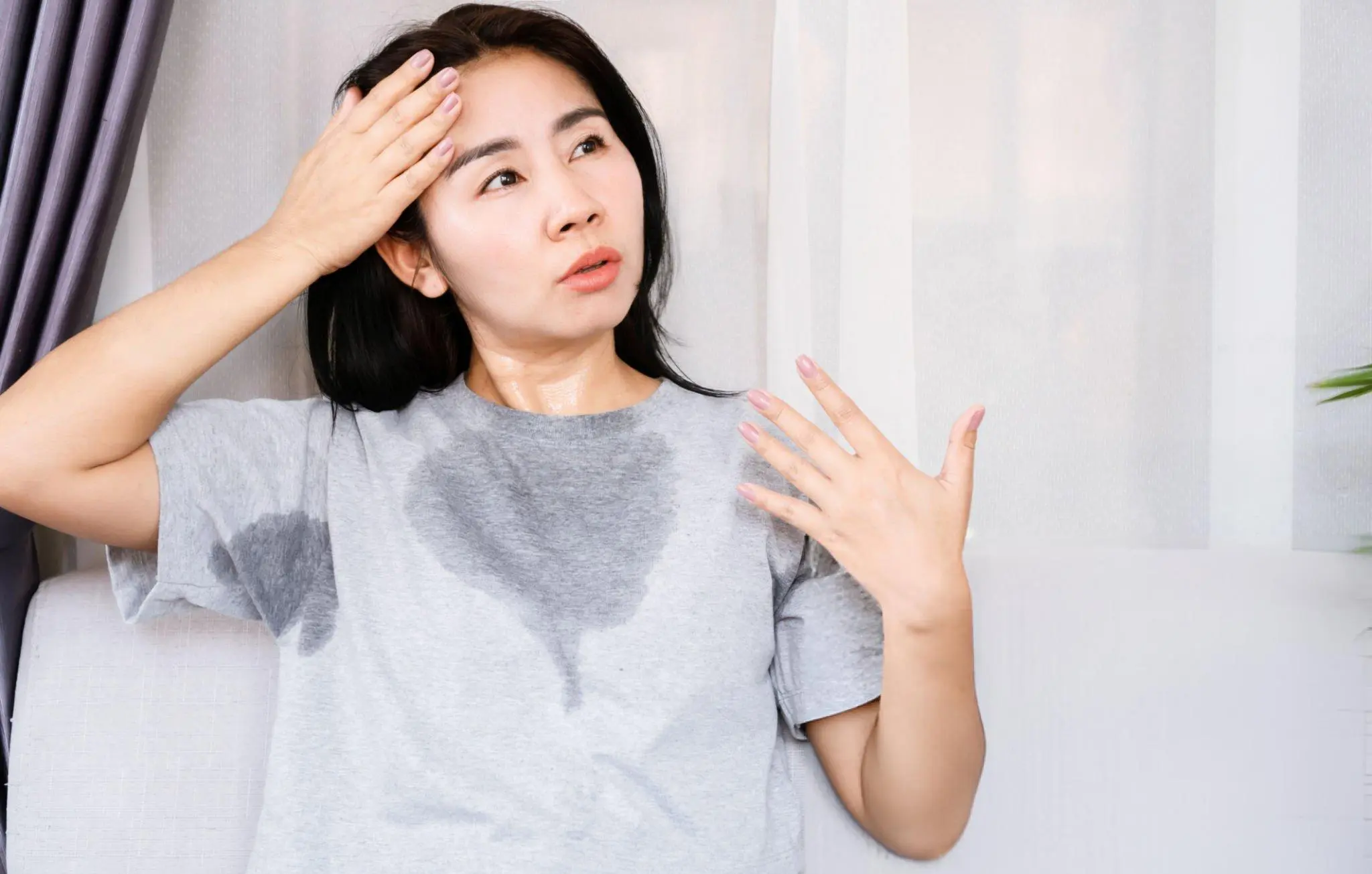What Is Axillary Hyperhidrosis and How Is It Treated?
If you’ve ever found yourself constantly checking for sweat stains under your arms or avoiding certain colors because they show moisture, you are not alone. Axillary hyperhidrosis affects millions of people worldwide, turning everyday situations into sources of anxiety and embarrassment.
This medical condition goes beyond normal sweating. While most people sweat when they are hot or nervous, those with axillary hyperhidrosis experience excessive underarm sweating that can happen anytime even when they are cool and relaxed. The good news? Effective treatments are available, and you don’t have to live with this frustrating condition forever.
If underarm sweating is affecting your daily life, Book Your Hyperhidrosis Treatment Today.
Understanding Axillary Hyperhidrosis
Axillary hyperhidrosis is a type of primary focal hyperhidrosis that specifically affects the underarm area. The word “axillary” refers to the armpit region, while “hyperhidrosis” means excessive sweating. This isn’t just about getting a bit sweaty during a workout it’s a legitimate medical condition that can seriously impact your quality of life.
People with this condition often produce four to five times more sweat than the average person in their underarm area. The sweating typically starts in adolescence or early adulthood and continues throughout life if left untreated. Unlike secondary hyperhidrosis, which is caused by underlying medical conditions or medications, primary axillary hyperhidrosis occurs on its own without any clear medical trigger.
The condition affects both men and women equally and can be particularly challenging for professionals, students, and anyone who needs to feel confident in social situations. Many people don’t realize that what they’re experiencing has a name and that help is available.
Also Read : https://skinduced.com.au/primary-vs-secondary-hyperhidrosis/
Recognizing the Symptoms of Axillary Hyperhidrosis
The main symptom is obvious excessive sweating in the underarm area that goes beyond what’s considered normal. But there are other signs that indicate you might be dealing with axillary hyperhidrosis rather than just regular perspiration.
You might notice that your underarms are constantly damp, even when you are not physically active or in a warm environment. The sweating often starts without any clear trigger and can happen at the most inconvenient times, during important meetings, social events, or even while you’re sleeping.
Other common symptoms include:
- Visible sweat stains on clothing within minutes of getting dressed
- Need to change shirts multiple times per day
- Avoiding certain fabrics or colors that show moisture
- White or colored stains on clothes from antiperspirant buildup
- Skin irritation or rashes in the underarm area from constant moisture
- Social anxiety about raising your arms or being in close contact with others
The psychological impact should not be underestimated. Many people with this condition report feeling anxious about social situations, limiting their clothing choices, or even avoiding activities they enjoy. Some feel embarrassed about handshakes, hugs, or any situation where others might notice their sweating.
Struggling with constant sweat stains? Schedule a Consultation Now.
What Causes Excessive Underarm Sweating?
Primary axillary hyperhidrosis is linked to an overactive nervous system. Your sympathetic nervous system controls many automatic body functions, including sweating. In people with hyperhidrosis, this system sends signals to produce sweat even when cooling isn’t needed.
Genetics plays a role too. About 30-50% of people with hyperhidrosis have a family member who also experiences excessive sweating. If your parents or siblings deal with similar issues, there’s a higher chance you might develop it as well.
The condition often starts during puberty when hormone levels change, but it can begin at any age. Stress, anxiety, and certain foods or drinks might make symptoms worse, but they don’t cause the condition itself. Some people notice their sweating increases when they feel anxious, which can create a cycle where worry about sweating leads to more sweating.
It’s important to understand that this isn’t about poor hygiene or not using the right products. People with axillary hyperhidrosis are often meticulous about cleanliness and try numerous over the counter solutions before seeking medical help.
The Impact on Daily Life
Living with axillary hyperhidrosis affects more than just your comfort – it can influence career choices, relationships, and overall confidence. Many people develop coping strategies that become second nature, like always wearing dark colors, layering clothing, or carrying extra shirts.
Professional situations can be particularly challenging. Job interviews, presentations, and networking events become sources of stress. Some people avoid careers that require formal attire or close contact with others. The constant worry about visible sweat marks can be mentally exhausting.
Social relationships may suffer too. Dating becomes complicated when you’re worried about intimate contact or wearing light-colored clothing. Simple activities like dancing, exercising with others, or even hugging friends can feel uncomfortable.
The International Hyperhidrosis Society reports that people with this condition often experience depression, anxiety, and reduced quality of life. The good news is that effective treatments can restore confidence and freedom to live life fully.
Treatment Options for Axillary Hyperhidrosis
Want to know which treatment is right for you? Talk to Our Specialists in Newcastle Today.
Topical Treatments
The first line of treatment usually involves prescription-strength antiperspirants containing aluminum chloride. These are much stronger than over the counter options and work by blocking sweat ducts. They are typically applied at night to dry skin and washed off in the morning.
While these can be effective for mild to moderate cases, they often cause skin irritation including itching, burning, or rashes. Some people find them too harsh for regular use, especially on sensitive underarm skin.
Botulinum Toxin Injections
Botox injections have become one of the most popular and effective treatments for axillary hyperhidrosis. The botulinum toxin temporarily blocks the nerve signals that trigger sweating, providing relief that typically lasts 6-12 months.
The treatment involves multiple small injections across the underarm area. While it sounds intimidating, most people find it quite tolerable. Results usually begin within a few days and peak effectiveness occurs within two weeks.
Studies show that botulinum toxin injections can reduce sweating by 82-87% in most patients. The main downside is that treatments need to be repeated regularly, and some people may experience temporary weakness in nearby muscles.
Oral Medications
Anticholinergic medications can help reduce sweating throughout the body, but they’re not always the first choice for localized axillary hyperhidrosis. These medications work by blocking chemical signals in the nervous system that trigger sweat production.
Side effects can include dry mouth, blurred vision, constipation, and difficulty with temperature regulation. Because they affect the entire body, many doctors prefer localized treatments for underarm sweating.
Energy-Based Treatments
Newer technologies use controlled energy to target and destroy sweat glands permanently. These treatments include microwave therapy and focused ultrasound. The procedures are typically done in-office with local anesthesia.
These methods can provide long-lasting results since they actually destroys sweat glands rather than temporarily blocking them. Recovery time is usually minimal, with most people returning to normal activities within a few days.
Surgical Options
For severe cases that don’t respond to other treatments, surgical procedures may be considered. Endoscopic thoracic sympathectomy involves cutting or clamping nerves that control sweating. However, this procedure carries risks and can cause compensatory sweating in other areas of the body.
Local surgical removal of sweat glands in the underarm area is another option, but it’s typically reserved for the most severe cases due to potential complications and scarring.
Choosing the Right Treatment
The best treatment depends on several factors including the severity of your symptoms, your lifestyle, and your tolerance for side effects. Mild cases might respond well to prescription antiperspirants, while more severe hyperhidrosis often requires medical procedures.
Many doctors recommend starting with less invasive options and progressing to more intensive treatments if needed. Some people find that combining treatments – like using prescription antiperspirants between Botox sessions – provides the best results.
Your age and overall health also influence treatment choices. Younger patients might prefer temporary solutions like Botox, while older adults may choose permanent options if they’re good surgical candidates.
Living with Confidence
Managing axillary hyperhidrosis isn’t just about reducing sweat – it’s about reclaiming your confidence and freedom. When treatments work effectively, people often describe feeling like they have their life back. Simple pleasures like wearing white shirts, raising your hand in meetings, or hugging friends become natural again.
The key is not letting embarrassment prevent you from seeking help. This is a recognized medical condition with proven treatments. You don’t have to accept excessive sweating as something you just have to live with.
Many patients report that their only regret is waiting so long to seek treatment. The sooner you address the problem, the sooner you can start enjoying activities and situations you might currently avoid.
When to See a Specialist
If over-the-counter antiperspirants aren’t controlling your underarm sweating, it’s time to consult a medical professional. You should also seek help if sweating is affecting your work, relationships, or daily activities.
Look for healthcare providers who have experience treating hyperhidrosis. Dermatologists and cosmetic clinics often specialize in these treatments and can offer the latest options including Botox injections and energy-based procedures.
Don’t feel embarrassed about discussing your symptoms. Medical professionals see patients with hyperhidrosis regularly and understand how significantly it can impact quality of life. They can help you explore all available options and find the treatment that works best for your specific situation.
Finding Relief in Newcastle
If you’re in Newcastle or surrounding NSW areas, you don’t have to travel far for effective hyperhidrosis treatment. Local specialists understand the challenges of living with excessive underarm sweating and can provide personalized treatment plans.
The climate in Australia can make hyperhidrosis symptoms feel worse, especially during summer months. Having access to effective treatment close to home means you can get relief quickly and maintain your results with regular follow-up appointments.
Modern treatments are much more comfortable and effective than older options. Many procedures can be completed during a lunch break, allowing you to return to your normal routine immediately.
At Skinduced Aesthetic Clinic in Newcastle, we provide safe and effective hyperhidrosis treatments. Don’t let excessive sweating control your life, Book Your Appointment Today.



